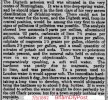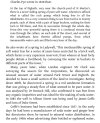Janet Hunt
master brummie
What happens if it is capped off Sean. Surely the water will look for a weak point elsewhere to spring up..(so to speak)?Very powerful flowing, if anybody wants to see then be quick, it may be gone tomorrow
What happens if it is capped off Sean. Surely the water will look for a weak point elsewhere to spring up..(so to speak)?Very powerful flowing, if anybody wants to see then be quick, it may be gone tomorrow
hi janet this is what myself and mike was saying...will the spring pop up somewhere else down the line...great find though as we dont often see this happen...thanks again to sean for keeping us updatedWhat happens if it is capped off Sean. Surely the water will look for a weak point elsewhere to spring up..(so to speak)?
So true lynn, I look forward to the next update...loving these postshi janet this is what myself and mike was saying...will the spring pop up somewhere else down the line...great find though as we dont often see this happen...thanks again to sean for keeping us updated
lyn
Mike that's brilliantI was wondering that as well Janet.. Have tried to clean up the photo of the spring
View attachment 175558
Thehi janet this is what myself and mike was saying...will the spring pop up somewhere else down the line...great find though as we dont often see this happen...thanks again to sean for keeping us updated
lyn
The process to ’cap’ or ’plug’ an aquifer or bore hole is a cement and bentonite mix give a positive pressure over the bore , some times puddling clay will be used . You are correct the is a risk the aquifer (by pressure) will appear again, but normally the area around the area to be plugged can be well pointed ( lower water table) while the plugging is being undertaken.hi janet this is what myself and mike was saying...will the spring pop up somewhere else down the line...great find though as we dont often see this happen...thanks again to sean for keeping us updated
lyn
Thank you for answering this, bit technical for me but it all sounds good. Question what if it appears some time late in a ground floor room of the new building. Also would having a natural spring underneath give instability in the long run. Surely it would be better to divert or utilise the natural source. Eg ornamental fountain or drinks water fountain.The
The process to ’cap’ or ’plug’ an aquifer or bore hole is a cement and bentonite mix give a positive pressure over the bore , some times puddling clay will be used . You are correct the is a risk the aquifer (by pressure) will appear again, but normally the area around the area to be plugged can be well pointed ( lower water table) while the plugging is being undertaken.
Hi,Thank you for answering this, bit technical for me but it all sounds good. Question what if it appears some time late in a ground floor room of the new building. Also would having a natural spring underneath give instability in the long run. Surely it would be better to divert or utilise the natural source. Eg ornamental fountain or drinks water fountain.
We have found what looks like a large copper pipe surrounded by steel or iron, it could be one of these bore holes, if so 250/300 feet is very very deep for me to chase it downBut would also point out this report from an earlier post referring to water to Lightfoot refrigeration, presumably originally from the spring here, but , according to the addition later from separate bore from the same source, which decreased in output consdierably
View attachment 175565
sean juts a little tip....when you come back to reading any thread always start reading from the last post you made by scrolling up the pages to your last post that way you do not miss any information posted by our members...as mike said he already reposted you the inscription which you will find on post 102 hope this helpsI did find the inscription on the tank in text somewhere before so i could read it, i cant find it now

If we could track down the full transcript i think it would make it a lot easier for me to explain to my boss in the morning to assess the situation, all info is good infoThis is the detail that I can decipher so far
This tank is 6 feet Wide and 12 feet deep ........It is kept Constantly filled with Pure Spring water by the spring which is 8 inches in Diameter and (100 ? 400?) feet deep .......... of tubes to prevent Surface impurities. The well (was opened?) in the year 1854 by Mr Clark of Maida Hill London. The Quantity of water which rises, if allowed, is 72,000 Gallons per Day. The .... is worked by the overflow
Shall try and track down the full transcript. Viv
I might need glasses because im struggling to make it outsean juts a little tip....when you come back to reading any thread always start reading from the last post you made by scrolling up the pages to your last post that way you do not miss any information posted by our members...as mike said he already reposted you the inscription which you will find on post 102 hope this helps
lyn

 birminghamhistory.co.uk
birminghamhistory.co.uk
 birminghamhistory.co.uk
birminghamhistory.co.uk
